Note: I am absolutely still writing these, but as may already be apparent we have been crazy busy. Will get them up as time permits!
Day three of our trip saw us heading outside of Prague, to the rural city of Kutna Hora. This meant, of course, sorting out how to use the trains.
If you’re European I think you are likely born with a few extra points in the “Use Train” skill; as a North American I had to work a bit to dredge up the remnants of my backpacking knowledge. Right. Train number, car number, seat number. Even so, Prague’s main train station can be overwhelming. There’s a riot of…everything going on: crowds of people with giant suitcases, a somewhat puzzling-to-outsiders numbering system for the platforms that takes into account north or south platforms, different ticket windows for domestic vs international trains. Still, fortunately for us the language of buying tickets is fairly universal: two, Kutna Hora, return. Slip of paper in hand, we headed for the departures board and thence to the platform…
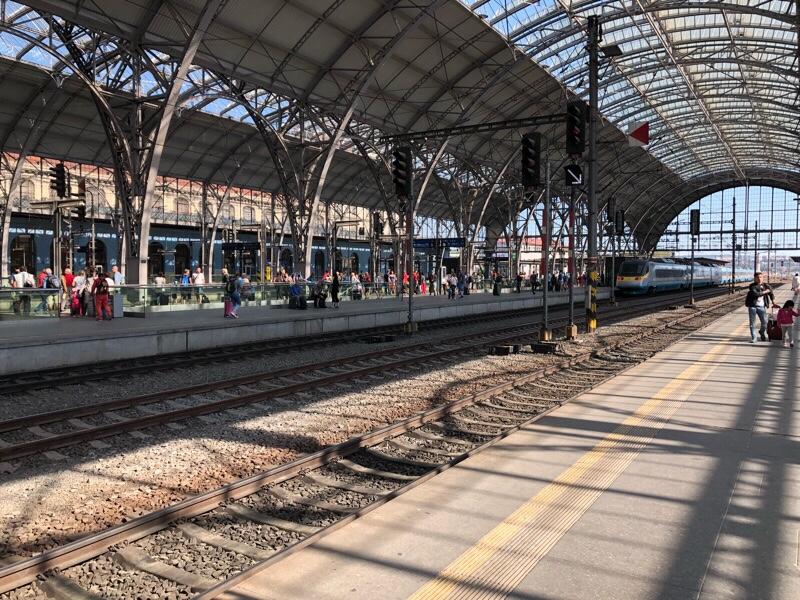
Where there were a LOT of people waiting. Perhaps it is because Kutna Hora is just that popular, or perhaps it was because it happened to be The Holiday Variously Known as V-E day or “Victory Day” or (as was written on some signs in the Czech Republic) “Liberation Day.” Be that as it may, we only barely scored a seat on the train before it rolled out into the Czech countryside.
The city gave way to green countryside of the sort I have been watching so often in Mark’s playthrough of Kingdom Come, and the stations grew progressively smaller and…well, not dingier precisely. Careworn, perhaps, with weary-looking painted plaster walls encrusted thickly with graffiti.
Kutna Hora’s main station has two platforms, brown painted plaster, and, like Prague’s main station, a startling lack of staff. From there it was a matter of transferring to a tiny yellow train that lumbered along gently to our first stop of the day.
Kutna Hora is best known for two things: silver mining (the translation of the town’s name was presented to us at least once as “to mine the mountain”) and the Sedlec Ossuary, which you might already know as “The Bone Church.”
This tiny chapel had its cemetery consecrated with earth from the holy land, once upon a time – a desirable state of affairs if you are religious and it’s the Middle Ages. So popular was this place for burials that they ran very quickly out of room…and found themselves having to disinter old corpses to make way for new ones.
What to do with all those bones? I’m not sure who it was that said “I know! Let’s stack them up into impressive pyramids, hang them on all the available wall space we’ve got, and build us a memento mori that people who use the word “Goths” to describe themselves centuries from now will daydream about visiting!”
But here we are. It’s not a BIG ossuary – you can tour the whole in perhaps twenty minutes – but it’s definitely something.

It’s clearly popular with more than just the Goth set, too: the place was already pretty mobbed when we arrived, packed with assorted Russians, Germans, a handful of North American folks and at least one bus’s worth of Chinese tourists. I think the bit I liked best is this little detail from the crest of the local lord depicted here; a skull decked out in the style of an Ottoman Turk would be getting its eyes pecked out, if it had any, by a raven.
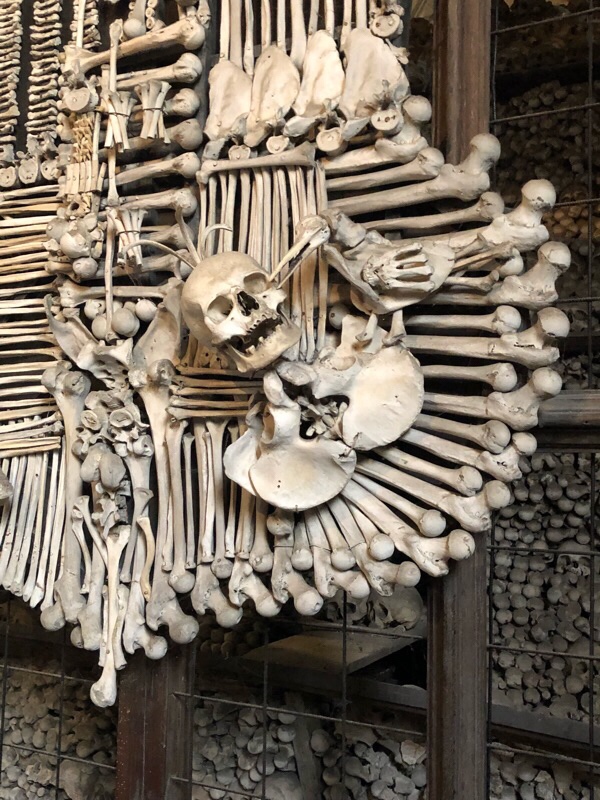
From there we had to find a place to catch a local bus a bit further in to the city centre. After some blundering about looking for the station (and making the discovery that English is less common outside Prague), we found ourselves waiting in the company of a very, very Goth-looking couple who had apparently hired a local guide for the day. The woman had jet-black dreads and a fairly epic Medusa tattoo; we saw the two of them around quite regularly for the rest of the day.
As we rode the bus, idly surveying the landscape of what looked like some of those little Communist-era apartments (painted in multicoloured plaster, like Prague, but far less romantic-looking), we happened to look right and see…an elephant.
Seriously. Real live elephant, just hanging out munching on some tree branches. A handful of people looking on as if to say “what the fuck do we do about this?” (A reasonable response really.)
As Mark and I swapped “WTF?” looks of our own, the local fellow guiding the Goths mentioned that the elephant was apparently an escapee from a circus that had come to town of late. Nobody was sure what to DO about it. (I wondered if he was having them on…but there WERE posters for a circus with recent dates.)
Hopping off the bus, it was time to walk downhill to St. Barbara’s Church. Remember how I said the name of the town is suggestive of mountains? I MEAN it about “downhill.” Imagine a town paved with mostly medieval cobbles (the hard rounded kind), pitched at about a 45 degree or more angle, and there you have it. The notion of cycling there is frankly terrifying.

St. Barbara’s is as Gothic as the ossuary, though more in the architecture sense than fans of, say, The Crow. Once upon a time, you see, this little town was not just wealthy but fantastically so; its silver mines were part of the Bohemian infrastructure that provided silver to most of Europe for a surprisingly long time. Professionals in coin minting were imported from Italy; the ruler of the land paid regular visits, and according to the locals this little place was once a contender for capital city of the region.
Why am I telling you all this now? Because this church was to be a no expenses spared showpiece, and you can kind of tell. Here, have a look:
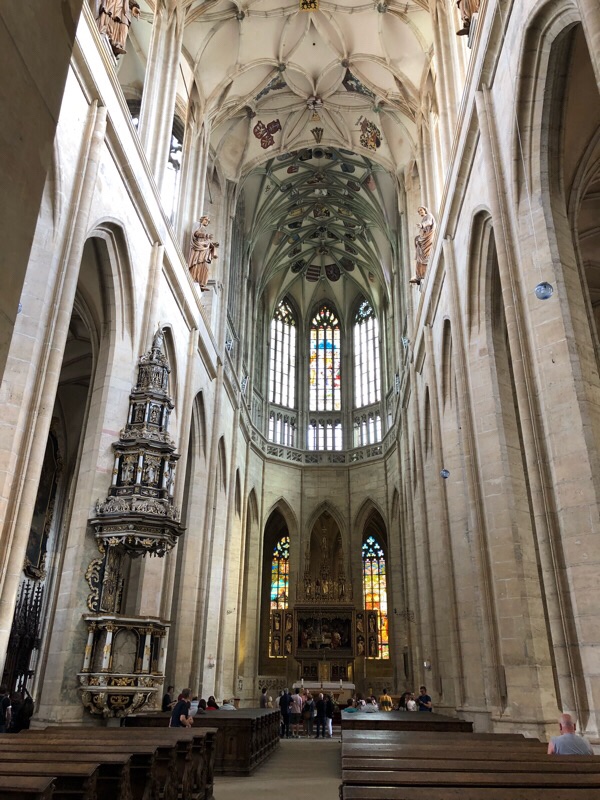
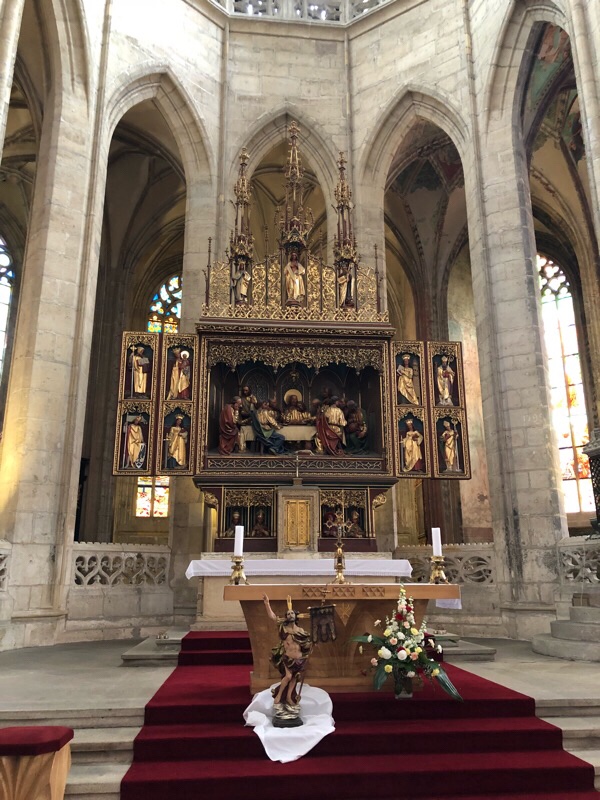

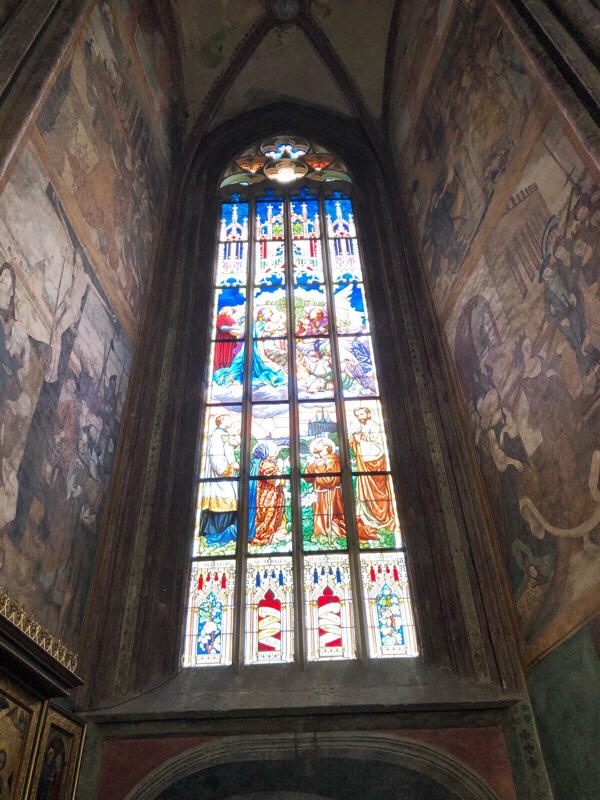
This fellow is wearing what we would shortly learn is a miner’s uniform – sensible, as St. Barbara is patron of miners:
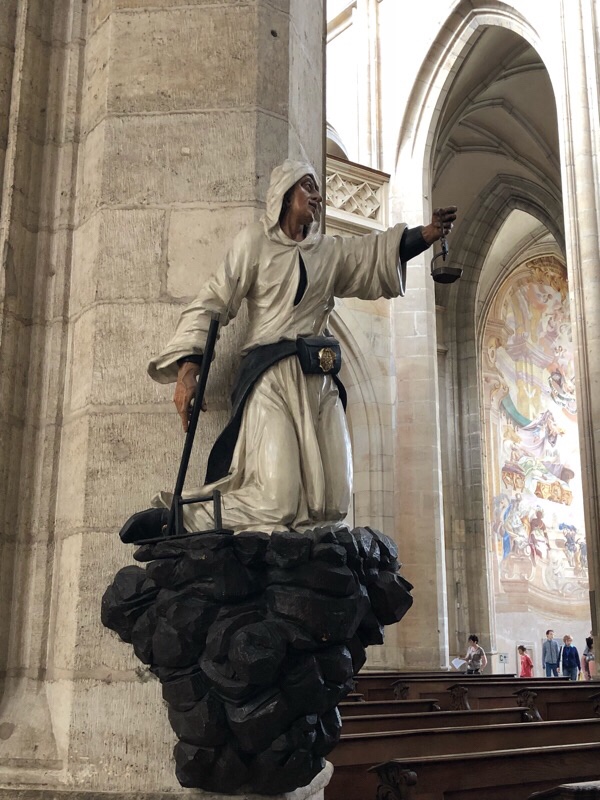
As it was lunchtime by now, we headed to a little pub-like spot on a public square, where we had a light lunch of “garlic soup with ham and cheese” and a lemonade we were relieved to find was made with lemons. (Previous experience had suggested that “lemonade” in Prague is more of a…family of beverages that might include all sorts of fruit.)
Then it was time to learn a bit more about where all this silver came from.
Silver mining in the Middle Ages was a scary business. Miners would crawl out of bed at a terrifyingly early hour to make their way down to the mine for their eight-hour shifts. To do this they would don a kind of white robe with a hood along with some sturdy leather apron-type garment that could be used to (for instance) slide down chutes deeper into the mine. Grab a tallow lamp and you’re all set to crawl in and set to…literally: exploratory passages were very low to the ground, to save the bother of mining out all that unnecessary stone. Miners worked in the near-dark, in damp tunnels, hunting for silver ore that was nearly black in its unrefined state; in the absence of visual cues they learned to rely on the feel of stone under hammers and picks, or on the smell of the dust. Smell something like garlic? You might be in luck! A complex system of code knocks helped them communicate with one another.
Miners had to be young unmarried men, and there is a great reason for that: the job was horrifically dangerous, and they lost something on the order of five miners per day.
Per day. Think about that for a second.
It was during our pre-mine talk with our guide Luci that we heard another possible origin of the town’s name, as well: a saint had a dream here once about some silver rods, and from these the town gets its name.
Poetic, but less likely, perhaps.
We headed down into the mines and got to hear a bit more about why they’re so dangerous: gases given off from wood as it rots underground, arsenic leaching from the stone into the water and poisoning everyone; losing your light and getting lost, tunnel collapses…et cetera. All in all I’m cool with my desk job, thanks.
As part of the tour we get to don the white miners’ robes ourselves (with modern helmets, fortunately) and squeeze into a tiny area of the mines. And I mean “turn sideways and squish through as tightly as possible” tiny. Here’s Mark in his outfit:
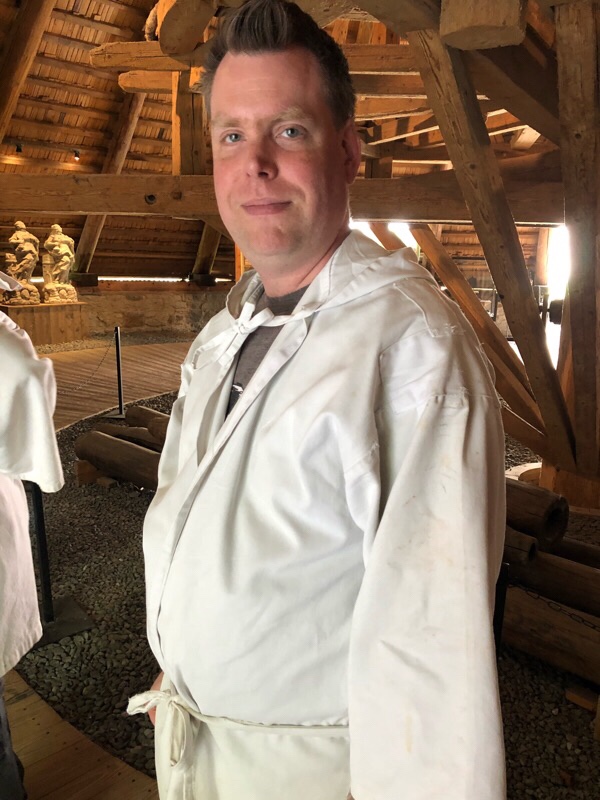
And here are some representative shots of the tunnels:
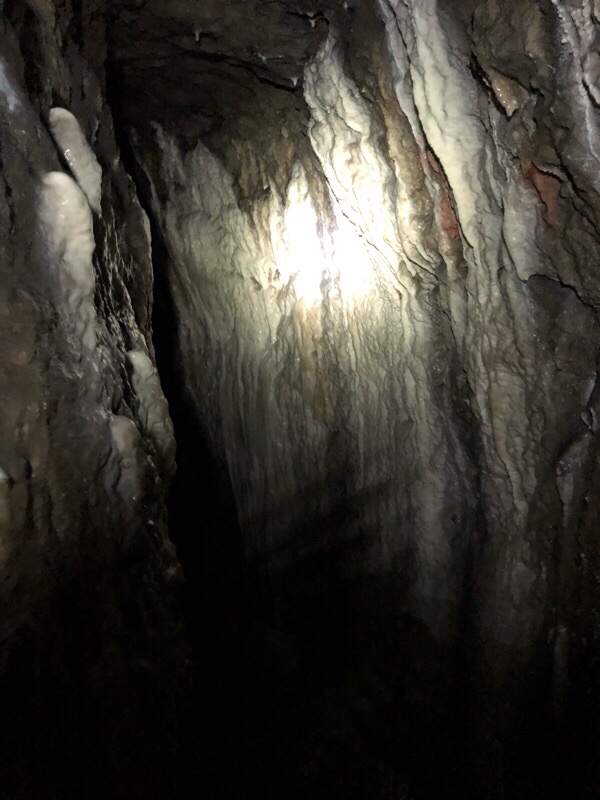

The mines are surprisingly wet; in at least one place you can shine the light from your helmet down to see water in a deeper shaft. How deep do they go? I’m not sure, but apparently nobody’s all that certain how many miles of tunnel exist just now. It was certainly interesting but overall…yeah, I am happy to be working above ground.
We also toured the above ground museum of silver with a lady who apologized profusely for her English, as she hadn’t used it in some 40 years (!). This bit of the tour I’ll just skim, as it was mainly collections of artifacts from the town accompanied by descriptions of how daily life was: medieval history fans, you probably already know all you need to know about this. I did enjoy the chest that locked and unlocked twelve locks at once using a single key:
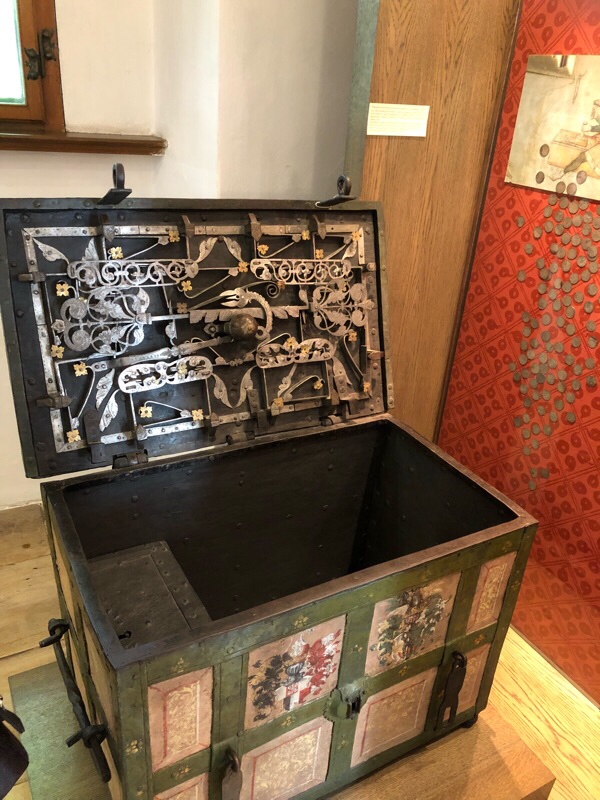
For good measure, the real keyhole isn’t the visible one on the front, either.
The silver museum also has a temporary exhibit space. On right now: gingerbread.
I know, I know, but it IS some impressive gingerbread:

After this we took a stroll downhill to see the rest of Kutna Hora. It has some pretty impressive drinking fountain infrastructure:
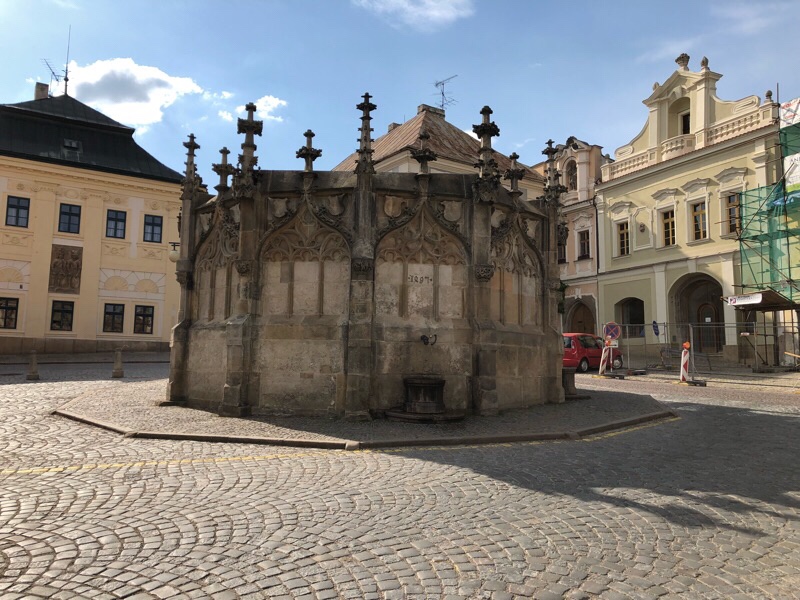
This would have been quite necessary at the time it was built due to the other major side effect of the mining: turning the land around the town into an arsenic-blighted hellscape. Today the land around Kutna Hora is pretty pleasant and green, but they would have chopped down all the local trees either for wood or for charcoal, and for years had to have both wood AND water shipped in. Ugh.

Eventually we made our way down to the little pink train station to catch the train back to Prague. Here there was a bit of an unpleasant surprise: apparently it’s totally possible to end up standing the entire way to your destination if you haven’t reserved a seat. (Pro tip for anyone trying this in future.)
Still, there was nothing for it – and so, feet burning rather fiercely by now after a day’s hard haul over rough cobble at a steep angle, we rode. A woman carrying a bright pink Hello Kitty bag wandered the aisles the entire trip, I assume watching for a space to open up. A youngish guy who looked as though he could bench-press me checked his phone, the outline of a set of brass knuckles alarmingly plain through his jeans. Business folk checked emails and kicked off high heeled shoes as far as public decency would seem to permit. Countryside directly out of Kingdom Come eventually gave way to suburbs, and then to office towers, and then to Prague.
We weren’t quite done with the day yet, though: hopping onto the somewhat-grungy-but-still-pretty-effective metro, we made our way to the evening’s planned entertainment: the National Marionette Theatre’s production of Don Giovanni. (The Czechs apparently have an honourable tradition of puppetry, and we’ve heard that this was a superior choice to some of the “black light” theatre shows.)
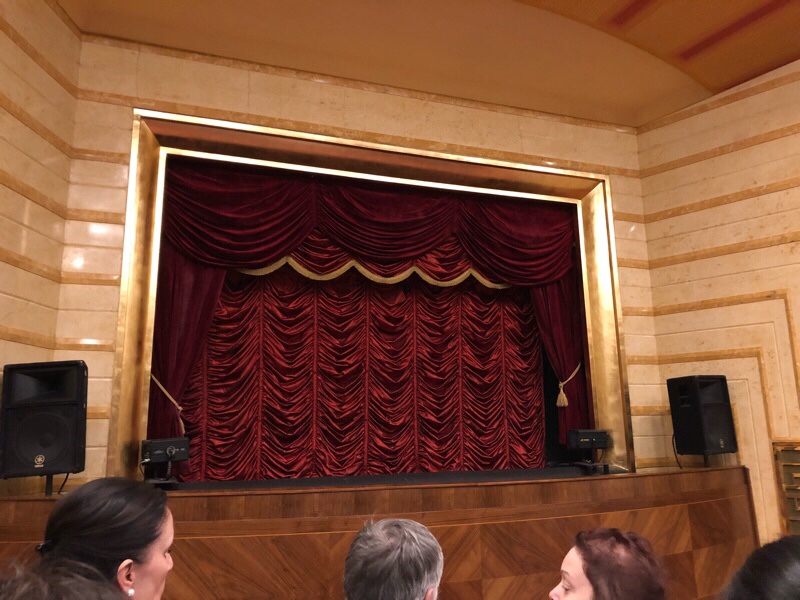
The theatre is a cute little Art Deco-ish affair, and while I can’t show you photos of the performance (here’s a review with representative examples) it was actually quite entertaining in a whimsical sort of way. The puppets don’t do any singing – it’s a recording – but that’s fine, as the real star here is the surprising physicality of the puppeteers’ performance.
Yes, the characters on stage are puppets; but the show really leans in to that, with charming results. The show’s been cut significantly, of course, and if you don’t speak Italian I would advise reading the plot on Wikipedia or something beforehand so you will have at least a vague clue what’s going on. It’s also threaded through with wry and often dark nonverbal humor; when a puppet character “dies” the puppeteer sags over the rail as if their own strings have been cut, and a backdrop stubbornly refuses to unfurl, stalling the opening of a scene.
I think I particularly enjoyed the inclusion of Mozart as the maestro. He’s controlled from below, unlike the other puppets, but his gestures are weirdly expressive and play nicely into what’s going on onstage. (And, of course, he premiered this show in Prague, so it’s appropriate.) At one point in the show he seemingly gets so frustrated by the other puppets’ antics that he just gets good and drunk and passes out, while the rest of the cast tries to work around his snoring form.
Eventually Giovanni gets hauled off to hell, the puppeteers have some amusing reactions to the overlong concluding sequence, and the audience files out.
In our case this was in search of a late dinner. This turned out to be some serviceable if unexceptional Czech food at a place Mark described as “what happens when The Witcher collides with a TGI Friday’s.” There was a tableful of blonde ladies eating fried cheese, and a very excited Japanese couple. Goulash for me, roast duck for Mark, with some more of those big bread dumplings. Beer lovers in the audience may wish to note that the beer was literally cheaper than the water. By, like, ten crowns.
This done, we headed back to the hotel to collapse, orienting ourselves via the House of Death, but not before spotting some more golem memorabilia on the way. (I think Mark has the pictures of that, sadly.)